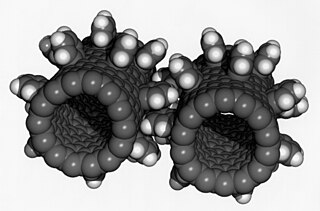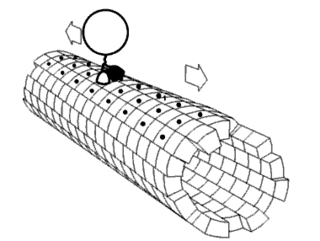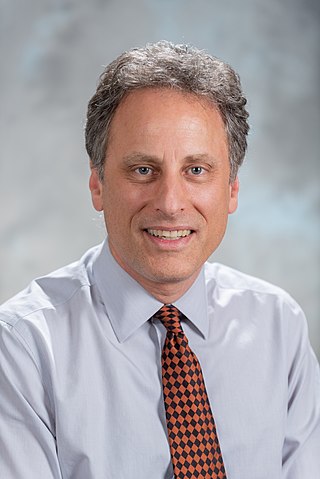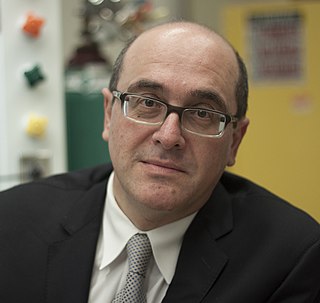Related Research Articles

Nanotechnology is the manipulation of matter with at least one dimension sized from 1 to 100 nanometers (nm). At this scale, commonly known as the nanoscale, surface area and quantum mechanical effects become important in describing properties of matter. This definition of nanotechnology includes all types of research and technologies that deal with these special properties. It is common to see the plural form "nanotechnologies" as well as "nanoscale technologies" to refer to research and applications whose common trait is scale. An earlier understanding of nanotechnology referred to the particular technological goal of precisely manipulating atoms and molecules for fabricating macroscale products, now referred to as molecular nanotechnology.
Nanomedicine is the medical application of nanotechnology. Nanomedicine ranges from the medical applications of nanomaterials and biological devices, to nanoelectronic biosensors, and even possible future applications of molecular nanotechnology such as biological machines. Current problems for nanomedicine involve understanding the issues related to toxicity and environmental impact of nanoscale materials.

Nanoid robotics, or for short, nanorobotics or nanobotics, is an emerging technology field creating machines or robots, which are called nanorobots or simply nanobots, whose components are at or near the scale of a nanometer. More specifically, nanorobotics refers to the nanotechnology engineering discipline of designing and building nanorobots with devices ranging in size from 0.1 to 10 micrometres and constructed of nanoscale or molecular components. The terms nanobot, nanoid, nanite, nanomachine and nanomite have also been used to describe such devices currently under research and development.

Nanobiotechnology, bionanotechnology, and nanobiology are terms that refer to the intersection of nanotechnology and biology. Given that the subject is one that has only emerged very recently, bionanotechnology and nanobiotechnology serve as blanket terms for various related technologies.

Nanochemistry is an emerging sub-discipline of the chemical and material sciences that deals with the development of new methods for creating nanoscale materials. The term "nanochemistry" was first used by Ozin in 1992 as 'the uses of chemical synthesis to reproducibly afford nanomaterials from the atom "up", contrary to the nanoengineering and nanophysics approach that operates from the bulk "down"'. Nanochemistry focuses on solid-state chemistry that emphasizes synthesis of building blocks that are dependent on size, surface, shape, and defect properties, rather than the actual production of matter. Atomic and molecular properties mainly deal with the degrees of freedom of atoms in the periodic table. However, nanochemistry introduced other degrees of freedom that controls material's behaviors by transformation into solutions. Nanoscale objects exhibit novel material properties, largely as a consequence of their finite small size. Several chemical modifications on nanometer-scaled structures approve size dependent effects.
The impact of nanotechnology extends from its medical, ethical, mental, legal and environmental applications, to fields such as engineering, biology, chemistry, computing, materials science, and communications.

The Friedrich Miescher Institute for Biomedical Research (FMI) is a biomedical research institute founded in 1970. Based in Basel, Switzerland, the FMI is affiliated with the University of Basel and the Novartis Institutes for BioMedical Research (NIBR). It is named after Friedrich Miescher. As of 2021, the FMI has around 340 collaborators, of which 20 are research group leaders, over 80 are postdoctoral collaborators and over 80 are postgraduate students participating in the FMI International PhD Program. The FMI is directed by Dirk Schübeler.
Heart nanotechnology is the "Engineering of functional systems at the molecular scale".
The applications of nanotechnology, commonly incorporate industrial, medicinal, and energy uses. These include more durable construction materials, therapeutic drug delivery, and higher density hydrogen fuel cells that are environmentally friendly. Being that nanoparticles and nanodevices are highly versatile through modification of their physiochemical properties, they have found uses in nanoscale electronics, cancer treatments, vaccines, hydrogen fuel cells, and nanographene batteries.
Vladimir Petrovich Torchilin is a Soviet, Russian and American biochemist, pharmacologist, and an expert in medical nanotechnology. Torchillin is a University Distinguished Professor of Pharmaceutical Sciences at Northeastern University. He also serves as a director at both the Center for Translational Cancer Nanomedicine and at the Center for Pharmaceutical Biotechnology and Nanomedicine at Northeastern University.
Bernd Pichler is a German biomedical engineer and expert in preclinical and molecular imaging as well as in imaging technology. He is Chair of the Department of Preclinical Imaging and Radiopharmacy as well as Director of the Werner Siemens Imaging Center at the University of Tübingen, Germany. He is the dean of the Faculty of Medicine of the University of Tübingen and member of the University Hospital Executive Board of Directors.
Nanoinformatics is the application of informatics to nanotechnology. It is an interdisciplinary field that develops methods and software tools for understanding nanomaterials, their properties, and their interactions with biological entities, and using that information more efficiently. It differs from cheminformatics in that nanomaterials usually involve nonuniform collections of particles that have distributions of physical properties that must be specified. The nanoinformatics infrastructure includes ontologies for nanomaterials, file formats, and data repositories.
Patrick Couvreur, born 1950 in Schaerbeek (Brussels), is a French pharmacologist who specialises in medical nanotechnology and is currently professor at the University of Paris-Sud.
Thomas J. Webster is an American biomedical engineer, researcher, and entrepreneur. Throughout his over 25-year academic career, his research group has produced several books and book chapters. He has over 1350 publications and has an H-index of 118.
Hamid Ghandehari is an Iranian-American drug delivery research scientist, and a professor in the Departments of Pharmaceutics and Pharmaceutical Chemistry and Biomedical Engineering at the University of Utah. His research is focused in recombinant polymers for drug and gene delivery, nanotoxicology of dendritic and inorganic constructs, water-soluble polymers for targeted delivery and poly(amidoamine) dendrimers for oral delivery.

Mark Robert Prausnitz is an American chemical engineer, currently Regents’ Professor and J. Erskine Love, Jr. Chair in Chemical & Biomolecular Engineering at the Georgia Institute of Technology. He also serves as adjunct professor of biomedical engineering at Emory University and Adjunct Professor of Chemical & Biomolecular Engineering at the Korea Advanced Institute of Science and Technology. He is known for pioneering microneedle technology for minimally invasive drug and vaccine administration, which has found applications in transdermal, ocular, oral, and sustained release delivery systems.

Alexander Viktorovich Kabanov, is a Russian and American chemist, an educator, an entrepreneur, and a researcher in the fields of drug delivery and nanomedicine.
Moein Moghimi is a British professor and researcher in the fields of nanomedicine, drug delivery and biomaterials. He is currently the professor of Pharmaceutics and Nanomedicine at the School of Pharmacy and the Translational and Clinical Research Institute at Newcastle University. He is also an adjoint professor at the Skaggs School of Pharmacy, University of Colorado Denver.

Lajos Peter Balogh, mainly referred to as Lou Balogh, is a Hungarian-American scientist known for his research on polymers, dendrimer nanocomposites, and nanomedicine. Balogh is the editor-in-chief of Precision Nanomedicine (PRNANO). Based on his career-long citation numbers, he belongs to the World's Top 2% Scientists.
Ankur Singh is an Indian-American biomedical engineer and scientist whose research focuses on engineering immune system. He is a Carl Ring Family Endowed Professor at Georgia Institute of Technology in the George W. Woodruff School of Mechanical Engineering and Wallace H. Coulter Department of Biomedical Engineering. He serves as the Director of the Center for Immunoengineering at Georgia Tech.
References
- 1 2 "Mauro Ferrari". Scholar.google.com. Retrieved 13 June 2017.
- 1 2 "Nano-balls filled with poison wipe out metastatic cancer in mice". Science . 14 March 2016. Retrieved 23 July 2017.
- ↑ "National Cancer Institute Alliance for Nanotechnology". National Institutes of Health. Retrieved 2 March 2017.
- ↑ Kulkarni, Rajan (2007). "Nano-Bio-Genesis: tracing the rise of nanotechnology and nanobiotechnology as 'big science'". Journal of Biomedical Discovery and Collaboration. 2 (3): 3. doi: 10.1186/1747-5333-2-3 . PMC 1976605 . PMID 17629932.
- ↑ Burgess, Rob. 2012. "Understanding Nanomedicine: An Introductory Textbook". Singapore: Pan Stanford. ISBN 9789814316385
- ↑ Jones, Dan (2007). "Cancer nanotechnology: small, but heading for the big time". Nature Reviews Drug Discovery. 6 (3): 174–175. doi:10.1038/nrd2285. PMID 17396287. S2CID 7836010.
- ↑ "Nanotechnology". Nature Reviews Drug Discovery. 8 (11): 911. 2009. doi: 10.1038/nrd3029 .
- ↑ "Leadership Team - Board of Directors: Mauro Ferrari, PhD". Arrowhead Pharmaceuticals. Retrieved 5 January 2025.
- ↑ Ferrari, Mauro (23 March 2011). "Transcript: The Marvels of Nanotechnology" (PDF). Columbia University Crossroads Culture Center. Retrieved 28 February 2017.
- 1 2 3 Ferrari, Mauro (23 March 2011). "Event: The Marvels of Nanotechnology". Columbia University Crossroads Culture Center. Retrieved 28 February 2017.
- 1 2 Chien, Shanley (2017). "TMC Spotlight: Mauro Ferrari, Ph.D." TMC News. 4 (2): 7–8. Retrieved 2 March 2017.
- 1 2 "Mauro Ferrari, Ph.D Joins The Methodist Hospital Research Institute as President and CEO". Newswise. 12 August 2010. Retrieved 16 June 2017.
- ↑ Ferrari M (2009). "Straight talk with Mauro Ferrari". Nature Medicine. 15 (7): 716–7. doi:10.1038/nm0709-716. PMID 19584847. S2CID 205380426.
- 1 2 Commission appoints Mauro Ferrari as next President of the European Research Council European Commission, press release of 14 May 2019.
- ↑ "ERC member:Mauro Ferrari". European Research Council. Retrieved 5 January 2025.
- ↑ "EU science chief resigns with blast at coronavirus response". Financial Times. 7 April 2020. Retrieved 7 April 2020.
- ↑ "Frustrated president of EU's top science panel quits over COVID-19 response". The Globe and Mail Inc. 7 April 2020.
- 1 2 Ferrari, Mauro (7 April 2020). "Return to the Frontlines, to the Frontiers - Statement by Mauro Ferrari" . Retrieved 30 June 2020.
- ↑ McGee, Luke (10 April 2020). "Analysis: The EU has bungled its response to coronavirus and it might never fully recover". CNN. Retrieved 30 June 2020.
- 1 2 Wallace, Nicholas (8 April 2020). "Top EU scientist pushed out over coronavirus spat". Science Magazine. Retrieved 30 June 2020.
- ↑ European Research Council. "RESIGNATION OF MAURO FERRARI – STATEMENT BY THE SCIENTIFIC COUNCIL". ERC. Retrieved 8 April 2020.
- ↑ Resignation of Mauro Ferrari – Statement by the Scientific Council European Commission, ERC press release of 8 April 2020.
- ↑ Kelly, Éanna (16 April 2020). "Mauro Ferrari rejects criticism of his performance levelled by the European Research Council's scientific board: Ex-ERC chief defends his record and says he remains a supporter of the ERC's objectives". Science Business. Retrieved 10 May 2020.
- ↑ Lantier, Alex (13 April 2020). "Fired researcher Mauro Ferrari denounces EU inaction on COVID-19". wsws.org. Retrieved 10 May 2020.
- ↑ Wallace, Nicholas (14 April 2020). "EU science chief defends record after ouster over coronavirus plans". Science Magazine. Retrieved 30 June 2020.
- ↑ Kelly, Éanna; Hudson, Richard L. (29 October 2020). "Exclusive: A look inside the last days of Mauro Ferrari at the European Research Council". ScienceBusiness. Retrieved 26 May 2023.
- ↑ Mauro Ferrari AMBER.
- ↑ About Us Arrowhead Pharmaceuticals.
- ↑ Dead Sea Research Institute
- ↑ Engineering Leadership Board Cullen College of Engineering, University of Houston.
- ↑ "Mauro Ferrari". Houstonmethodist.org. Archived from the original on 14 November 2017. Retrieved 15 June 2017.
- ↑ "Phase 1 - Physical Sciences-Oncology Centers: The Methodist Hospital Research Institute". National Cancer Institute: Physical Sciences in Oncology. Retrieved 15 June 2017.
- ↑ Xu R, et al. (2016). "An injectable nanoparticle generator enhances delivery of cancer therapeutics". Nat Biotechnol. 34 (4): 414–8. doi:10.1038/nbt.3506. PMC 5070674 . PMID 26974511.
- ↑ Nizzero, Sara; Goel, Shreya; Hinkle, Louis E.; Wu, Xiaoyan; Li, Chao; Ferrari, Mauro; Shen, Haifa (June 2020). "Retraction of the Research Article: "Molecular targeting of FATP4 transporter for oral delivery of therapeutic peptide" by Z. Hu, S. Nizzero, S. Goel, L. E. Hinkle, X. Wu, C. Li, M. Ferrari and H. Shen". Science Advances. 6 (26): eabc9572. Bibcode:2020SciA....6.9572N. doi:10.1126/sciadv.abc9752. ISSN 2375-2548. PMC 7319764 . PMID 32637628.
- ↑ "Three BME Faculty Elected to American Institute for Medical and Biological Engineering (AIMBE) Fellows". The University of Texas. Retrieved 13 June 2017.
- ↑ "Mauro Ferrari". American Association for the Advancement of Science. Retrieved 13 June 2017.
- ↑ "CRS Founders Award Recipients". Controlledreleasesociety.org. Archived from the original on 5 July 2016. Retrieved 16 June 2017.
- ↑ "TNanomedicine pioneer Mauro Ferrari at ETH Zurich". ETH Zurich. 26 March 2015. Retrieved 16 June 2017.
- 1 2 Ferrari, Mauro (23 March 2011). "Transcript: The Marvels of Nanotechnology" (PDF). Columbia University Crossroads Culture Center. Retrieved 28 February 2017.